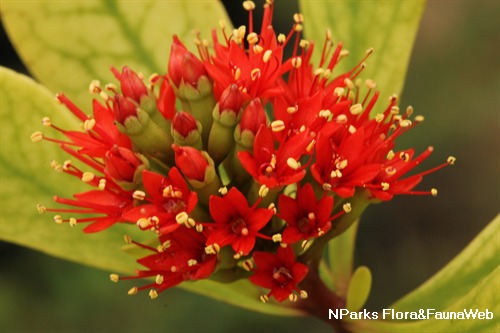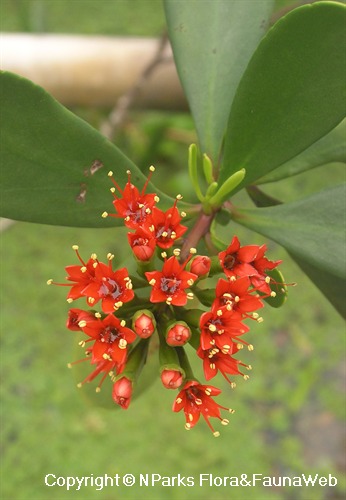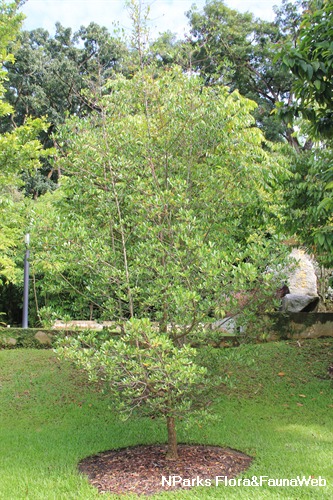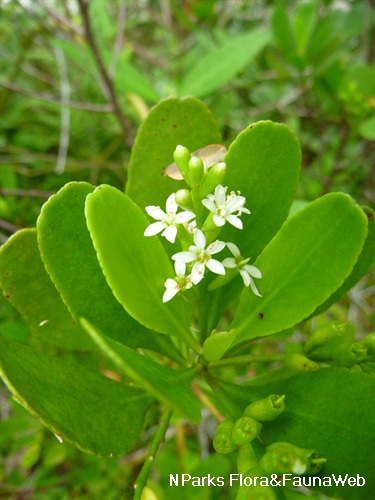
Back
Lumnitzera littorea (Jack) Voigt
| Family Name: | Combretaceae |
| Synonyms: | Lumnitzera coccinea Wight & Arn. |
| Common Name: | Teruntum Merah, Red Teruntum, Red-Flowered Black Mangrove, 红榄李 |
Name
Classifications and Characteristics
| Plant Division | Angiosperms (Flowering Seed Plants) (Dicotyledon) |
|---|---|
| Plant Growth Form | Tree (Medium (16m-30m)) |
| Lifespan (in Singapore) | Perennial |
| Mode of Nutrition | Autotrophic |
| Plant Shape | Oval, Irregular |
| Maximum Height | 25 m |
Biogeography
| Native Distribution | India, Sri Lanka, southern China, South East Asia (including Singapore), Australia and the Pacific Islands |
|---|---|
| Native Habitat | Shoreline (Mangrove Forest, Sandy Beach, Rocky Beach) |
| Preferred Climate Zone | Tropical, Sub-Tropical / Monsoonal |
| Local Conservation Status | Native to Singapore (Endangered (EN)) |
Description and Ethnobotany
| Growth Form | A relatively small to medium sized tree, reaching up to 25 m when growing in favourable conditions. It has no buttress, but produces pneumatophores. Bark is dark brown and fissured. |
|---|---|
| Foliage | Its alternate, shortly-stalked leaves have obovate leaf blades that are 2-9 by 1-2.5 cm, slightly thick and fleshy. |
| Flowers | Its shortly-stalked, scented flowers are 1-3 by 0.5 cm, with green fused sepals, and bright red petals. |
| Fruit | Its one-seeded fruits are vase-shaped, tinged red, and are 1-2 by 0.3-0.7 cm, with a fibrous fruit wall, allowing it to float. |
| Habitat | Found mostly at back mangrove forests and is usually gregarious. |
| Associated Fauna | Its flowers are pollinated by birds. |
| Cultivation | It can be propagated by seed. |
| Etymology | Latin Lumnitzera, commemorating St. Lumnitzer (1750–1806), a Hungarian botanist; Latin littorea, growing by the seashore, referring to its natural habitat. |
| Ethnobotanical Uses | Medicinal: The bark is used medicinally. The leaves are are used to cure pimples, spruce, thrush in infants, and promote hair growth. The roots are used to make a soothing and softening cream, and diuretic medicine. They are also used to induce perspiration, reduce fevers, and relieve constipation. Timber & Products: The wood is used as floats for gill nets, and building bridges, ships, and wharves. The wood is also used in making canoes, cart axles, flooring, furniture, sleepers and tool handles. Others: The bark is used to make grass skirts, ropes and strings. The branches can be used for fuel. |
Landscaping Features
| Landscaping | It is suitable for planting in waterlogged areas, in ponds, edges of waterbodies in parks or at coastal areas with brackish soils, for its bright red flowers, and attractive foliage. |
|---|---|
| Desirable Plant Features | Ornamental Flowers, Ornamental Foliage, Fragrant (Flowers) |
| Landscape Uses | Parks & Gardens, Small Gardens, Coastal, Riverine, Pond / Lake / River, Marsh / Bog |
Fauna, Pollination and Dispersal
| Fauna Pollination Dispersal Associated Fauna | Bird-Attracting (Flowers), Butterfly-Attracting |
|---|---|
| Pollination Method(s) | Biotic (Fauna) (Vertebrates (Bird)) |
| Seed or Spore Dispersal | Abiotic (Water) |
Plant Care and Propagation
| Light Preference | Full Sun, Semi-Shade |
|---|---|
| Water Preference | Lots of Water, Moderate Water |
| Plant Growth Rate | Moderate |
| Rootzone Tolerance | Moist Soils, Waterlogged Soils (Drains Site, Does not Drain Site), Saline Soils / Salt Spray, Fertile Loamy Soils, Heavy Clay Soils |
| Maintenance Requirements | Moderate |
| Propagation Method | Seed |
Foliar
| Foliage Retention | Evergreen |
|---|---|
| Mature Foliage Colour(s) | Green |
| Mature Foliage Texture(s) | Leathery, Thick |
| Foliar Type | Simple / Unifoliate |
| Foliar Arrangement Along Stem | Alternate |
| Foliar Attachment to Stem | Petiolate |
| Foliar Shape(s) | Non-Palm Foliage (Obovate) |
| Foliar Venation | Pinnate / Net |
| Foliar Margin | Entire |
| Foliar Apex - Tip | Rounded, Retuse |
Floral (Angiosperm)
| Flower & Plant Sexuality | Bisexual Flowers |
| Flower Colour(s) | Red |
|---|---|
| Flower Grouping | Cluster / Inflorescence |
| Flower Location | Axillary |
| Flower Symmetry | Radial |
Fruit, Seed and Spore
| Mature Fruit Colour(s) | Brown |
|---|---|
| Fruit Classification | Simple Fruit |
| Fruit Type | Indehiscent Dry Fruit |
Image Repository
Others
| Master ID | 1974 |
|---|---|
| Species ID | 3266 |
| Flora Disclaimer | The information in this website has been compiled from reliable sources, such as reference works on medicinal plants. It is not a substitute for medical advice or treatment and NParks does not purport to provide any medical advice. Readers should always consult his/her physician before using or consuming a plant for medicinal purposes. |






